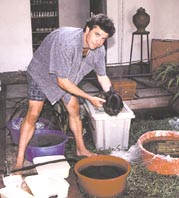 |
 6th December 1998 |
Front Page| |
Treasures in the seaBy Nilika de SilvaIn 1992 work began on a maritime cultural project in the Galle harbour. A team of archaeologists from Sri Lanka and Australia, launched a project to discover maritime sites in the ocean overlooked by the Galle Fort, which was a hub of activity in the Portuguese and Dutch periods of Ceylon. Although research on the shipwrecks in Galle was carried out previously, it was after the proposal to develop the Galle harbour that the need to conserve treasures buried in the ocean depths became an issue . Gamini Wijesuriya, Director of Conservation at the Department of Archaeology, said that when the Department first heard about the Galle Harbour Development Project, they told the Government that there must be some steps taken to ensure the prxotection of the maritime cultural heritage sites within this area. Research was conducted in depth and the location of over a hundred shipwrecks has been identified. Salvage operations will soon get underway, carefully bringing the sunken archaeological treasures to shore, after many centuries of underwater oblivion. The project includes the construction of a maritime laboratory. "In this laboratory, the rescued objects will be placed in sea water to mimic the undersea surroundings. Otherwise they might deteriorate due to the unfamiliar environment," explained Wijesuriya. The Government had made a generous contribution for this laboratory, which is now nearing completion , he added. "We were asked to do a very comprehensive study before the harbour development work began to see if it would, in any way, impact the archaeological sites within these environs." said Consultant Archaeologist working on the site, at Galle Gihan Jayatilleke.
A grant from the Ministries of Ports and Shipping and Cultural Affairs enabled the team to begin initial work on the site. "We were lent a side-scan sonar by the Fugro Trust, which could be used to pinpoint sites and also a magnetometer. "The Navy supplies us with logistical support in the form of boats and personnel. 190 targets (sites) were located within the harbour area. This means investigative dives have to be conducted on each site. Then you select according to priority which shipwrecks to dive on. Galle Harbour area being a restricted security zone coincidentally provides protection for the excavation sites," he said.The Galle Harbour Maritime Archaeology Project was launched in conjunction with Australia, as a research and training project. Anthony Coles, Attaché and Vice Consul, Australian High Commission, speaking of the maritime archaeological project said, "We've been supporting the project since inception. The number of Sri Lankan students working on it have increased dramatically. We're happy to see that the project is progressing." Dr. Jeremy Green acts as the Project Manager from Australia and has been involved with the research from the beginning with Karen Millar. They both hail from the Western Australian Maritime Museum.Today the team of maritime archaeologists working on this project includes personnel from Sri Lanka, Australia and The Netherlands. The Netherlands officially came into this project last year. Dr. Robert Parthesius, an Archaeologist from Amsterdam, provided Archival Research which relates to the VOC company. Much information was found through the records in the Archives in Colombo and The Hague. Many of the young people working on this project were archaeology undergraduates in 1993 who were trained in swimming and diving, and brought abreast of marine archaeology techniques. Soon there will be volunteers from other countries coming to work on the salvage operations. "They consider it a privilege to work on a site like this," said Jayatilleke "In the Indian Ocean area Sri Lanka seems to be doing the most scientific work," said Retired Lieutenant Commander S. Devendra, a member of the International Committee on Monuments and Sites (ICOMOS) and the Senior Advisor of the Galle project.Devendra will represent Sri Lanka at the World Underwater Cultural Heritage Convention to be held in Paris in April 1999. |
||
 |
More Plus * Knowing not what you do * Human rights go to court * Guardian of law misuses authority
Front Page| News/Comment| Editorial/Opinion| Business| Sports | Mirror Magazine |
|
 |
Please send your comments and suggestions on this web site to |
|
 The
long-term intention of the project is to establish a Maritime Research
Centre. "We have been working on a piece of legislation which will
afford protection to all historic shipwrecks and settlements. It will be
called the Maritime Heritage Protection Act. The final draft of the legislation
is presently with the Attorney General's Department and will soon be brought
to Parliament. An Authority will be created under the impending legislation,"
he added.
The
long-term intention of the project is to establish a Maritime Research
Centre. "We have been working on a piece of legislation which will
afford protection to all historic shipwrecks and settlements. It will be
called the Maritime Heritage Protection Act. The final draft of the legislation
is presently with the Attorney General's Department and will soon be brought
to Parliament. An Authority will be created under the impending legislation,"
he added.